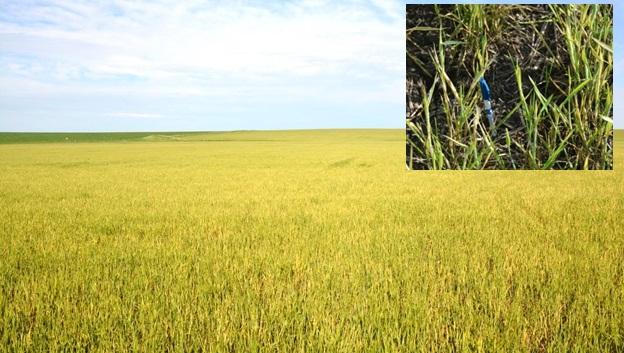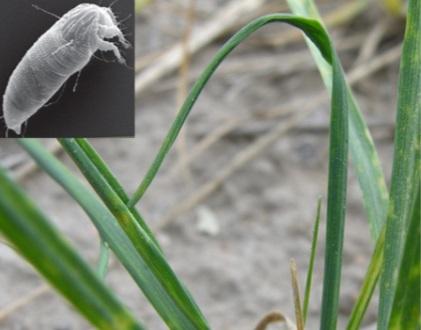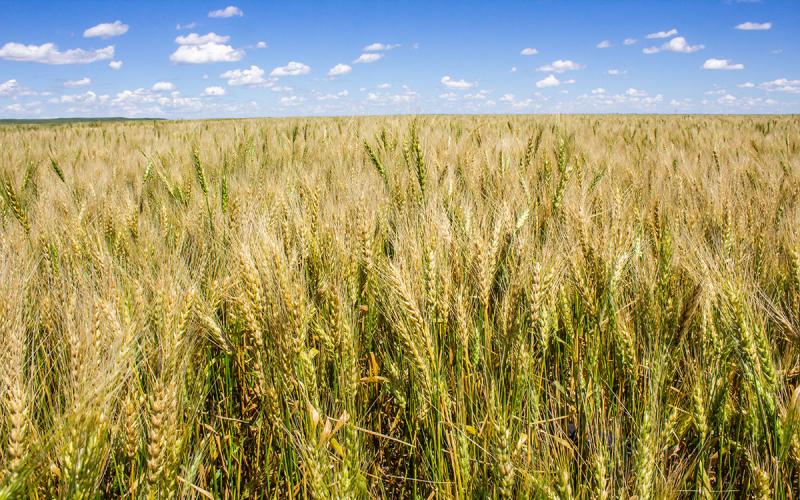Written collaboratively by Emmanuel Byamukama, former SDSU Extension Plant Pathologist, Anitha Chirumamilla, former SDSU Extension Entomology Field Specialist and Marie Langham.
Have you had a history of moderate wheat streak mosaic disease in your field? Do you plan on planting wheat into wheat stubble or wheat fallow? Have your neighbors had wheat streak mosaic disease outbreaks in the recent past? If you answered yes to any of these questions, you need to incorporate wheat streak mosaic control principles into your management plan before planting winter wheat this fall.
Wheat streak mosaic can be severe, at times leading to total loss when a wheat field is abandoned because of stunted plants that cannot be harvested by a combine or when the yield is so poor that it is not worth combining (Figure 1). Wheat streak mosaic disease is caused by a virus, called Wheat streak mosaic virus (WSMV). This virus is spread by the wheat curl mite (WCM), which can only be seen using at least 20x magnification (Figure 2). The WCM is unable to move long distances on its own, and they are carried to nearby fields by the wind. The WCM’s feeding alone is not as detrimental although heavy feeding can cause leaf curling, thus the name wheat curl mite (Figure 2). The main damage done by WCM is spreading WSMV. Once WCMs are deposited on the leaf surface, they move to the inner whorl near the growing point where they are protected.

WSMV management starts with understanding the origin of WSMV inoculum. WSMV is not spread through soil or residues. WSMV is spread through WCMs when they move from infected sources to healthy wheat plants. Therefore, while practices like rotation can be effective in management of several residue- and soil-borne diseases, rotation won’t be as effective if the neighboring field had WSMV. WCM acquires the virus by feeding on infected plants. As the plant quality starts to decline due to senescence, drought, or other stresses WCM moves to the upper leaf surfaces where they are picked up in the wind. If WCMs are deposited on young wheat plants, they will move near the growing point and continue feeding around the growing point until the wheat head emerges. WCM will also feed on the head near the kernels where the mites are also protected. As the wheat head starts to dry up and mature, WCM migration is initiated (generally in early summer).

The WCM completes its life cycle in 10 days, depending on the temperature, and goes through many generations in a season. Therefore, amazing numbers of WCM can be found on a single wheat plant. Towards the end of wheat growing season, WCM are picked up by wind, and are generally deposited on nearby areas (within two miles). WCM that end up in a wheat field can survive on volunteer wheat and grassy weeds. WCM deposited on a host crop (wheat, millet, corn, sorghum or grassy weeds), can also survive. If they land on broad leaved crops (e.g. sunflower, dry beans) or bare ground, their survival will be minimal. WCMs can survive without a suitable host for up to 24 hours.
When WCM land on young emerging wheat or grassy weeds in fall, they move and feed near the growing point of the plant, and they will overwinter on infested plants as adults, nymphs and eggs. WCM are winter hardy and as long as winter wheat or grassy weeds survive the winter, the WCM will also survive. As temperatures warm up in spring and wheat resumes growing, WCMs also start to feed and reproduce.
Considering how the WCM survives and moves, the risk factors for WSMV are the volunteer wheat and grassy weeds within a field or nearby fields or those on the edges surrounding the field. This is sometimes referred to as the “green bridge”. Volunteer wheat is a greater risk factor if there are hail events that cause grain to fall on the ground, enabling early sprouting and providing a survival host for WCM at wheat harvesting.
WSMV Management
Because the WCMs which spread WSMV come from volunteer wheat and grassy weeds, managing WSMV requires eliminating this source of the virus. Destroy any volunteer wheat and grassy weeds at least two weeks before planting wheat in fall. This can be achieved by treating with a desiccant or through tillage. Ensure that all green areas of treated volunteers have browned because WCM will move to remaining green patches on treated plants as they brown. If wheat is to be planted next to a field previously planted with wheat, the volunteer wheat and grassy weeds in this field should also be destroyed.
Delay wheat planting in fall for areas with a history of WSMV outbreaks. Planting early in fall increases the chances of WCM moving off drying wheat or grasses to young emerging wheat in fall. WSMV infections that take place in fall cause the most significant yield losses.
Plant WSMV resistant/tolerant wheat cultivars. One cultivar that has good resistance to WSMV is Mace (available from University of Nebraska Foundation Seed).
For areas with history of WSMV, avoid rotating wheat with small grain crops like pearl millet, oats, barley, etc. Rotate with broad leaved crops like sunflower, field peas, lentils etc.


